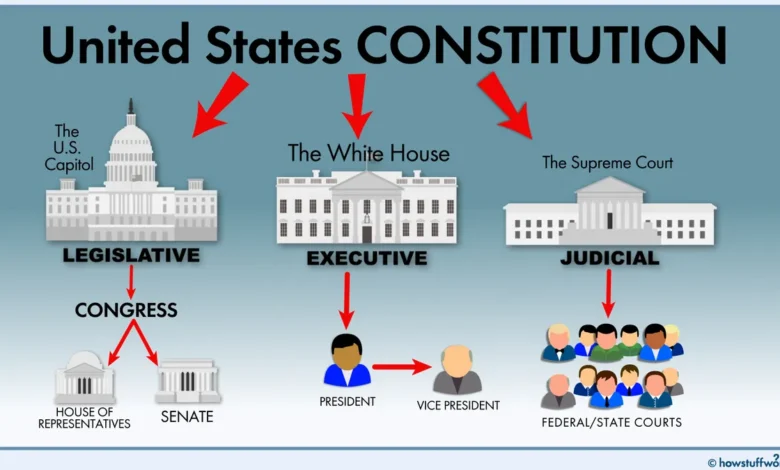The Executive Branch of the U.S. Government: Structure

Table of Contents
Introduction
The executive branch is a cornerstone of the United States government, responsible for implementing and enforcing laws passed by Congress. Established under Article II of the U.S. Constitution, it encompasses the President, Vice President, the Cabinet, and various federal agencies. This branch plays a pivotal role in shaping national policies and ensuring their execution.
Structure of the Executive Branch
1. The President
The President serves as the head of state and government, as well as the Commander-in-Chief of the armed forces. Elected every four years, the President’s primary duties include enforcing federal laws, conducting diplomacy, and overseeing the federal administration. The President also has the authority to issue executive orders, veto legislation, and appoint federal judges and officials.
2. The Vice President
The Vice President supports the President and is prepared to assume the presidency if the President is unable to serve. Additionally, the Vice President serves as the President of the Senate, casting tie-breaking votes when necessary.
3. The Cabinet
Comprising the heads of 15 executive departments, the Cabinet advises the President and helps implement federal policies. These departments include:
- Department of State
- Department of Defense
- Department of Justice
- Department of the Treasury
- Department of Homeland Security
- Department of Health and Human Services
- Department of Education
- Department of Energy
- Department of Housing and Urban Development
- Department of Transportation
- Department of Veterans Affairs
- Department of Agriculture
- Department of Commerce
- Department of Labor
- Department of Interior
4. Executive Office of the President (EOP)
Established in 1939, the EOP assists the President in managing the executive branch. It includes entities such as the Office of Management and Budget (OMB), the National Security Council (NSC), and the Council of Economic Advisers (CEA). These offices provide support in areas like budget preparation, national security, and economic policy.
5. Independent Agencies and Commissions
These entities operate independently of the executive departments but are still part of the executive branch. Examples include the Central Intelligence Agency (CIA), the Environmental Protection Agency (EPA), and the Federal Communications Commission (FCC). They have specific regulatory or enforcement responsibilities.
Powers and Responsibilities
1. Law Enforcement and Implementation
The executive branch ensures that federal laws are faithfully executed. This involves overseeing federal agencies that administer programs and enforce regulations.
2. Military Command
As Commander-in-Chief, the President has authority over the U.S. armed forces. While only Congress can declare war, the President can direct military operations and respond to threats.
3. Foreign Relations
The President manages diplomatic relations, negotiates and signs treaties (which require Senate ratification), and appoints ambassadors to represent the U.S. abroad.
4. Budget and Economic Policy
The executive branch plays a significant role in shaping economic policy. The President submits an annual budget proposal to Congress, outlining priorities for federal spending. Agencies like the OMB assist in this process.
5. Executive Orders and Actions
The President can issue executive orders to direct federal agencies and officials in their execution of laws and policies. These orders have the force of law and are used to manage operations within the federal government.
Recent Developments
In recent years, there have been significant developments within the executive branch:
- Reorganization of Federal Agencies: In March 2025, President Donald Trump signed an executive order to dismantle the U.S. Department of Education, initiating a process to reassign its functions to other agencies. This move has raised concerns about the future of federal education programs and student loan management.
- Expansion of Presidential Authority: In February 2025, President Trump signed an executive order placing independent agencies under White House control, thereby expanding presidential authority over entities like the FCC, FTC, and SEC. Critics argue this undermines the independence of these agencies.
- Legal Challenges: The application of the “unitary executive” theory, which posits that the president has sole control over the executive branch, has led to legal challenges. Actions such as the dismissal of certain agency heads have prompted debates over the extent of executive power.
Read More: The Fappening Blog: Lessons in Privacy, Ethics
Conclusion
The executive branch is essential to the functioning of the U.S. government, responsible for enforcing laws, managing foreign relations, overseeing the military, and implementing policies. Its structure, comprising the President, Vice President, Cabinet, and various agencies, ensures the effective administration of federal functions. Understanding the executive branch provides insight into how the U.S. government operates and responds to national and international challenges.
FAQs
1. What is the primary role of the executive branch?
The executive branch is responsible for enforcing and implementing the laws passed by Congress.
2. Who leads the executive branch?
The President of the United States leads the executive branch.
3. What is the Cabinet?
The Cabinet is composed of the heads of 15 executive departments who advise the President and help implement federal policies.
4. What are executive orders?
Executive orders are directives issued by the President to manage operations within the federal government.
5. How does the executive branch interact with other branches of government?
The executive branch works with the legislative branch to pass laws and with the judicial branch to ensure laws are constitutional.



